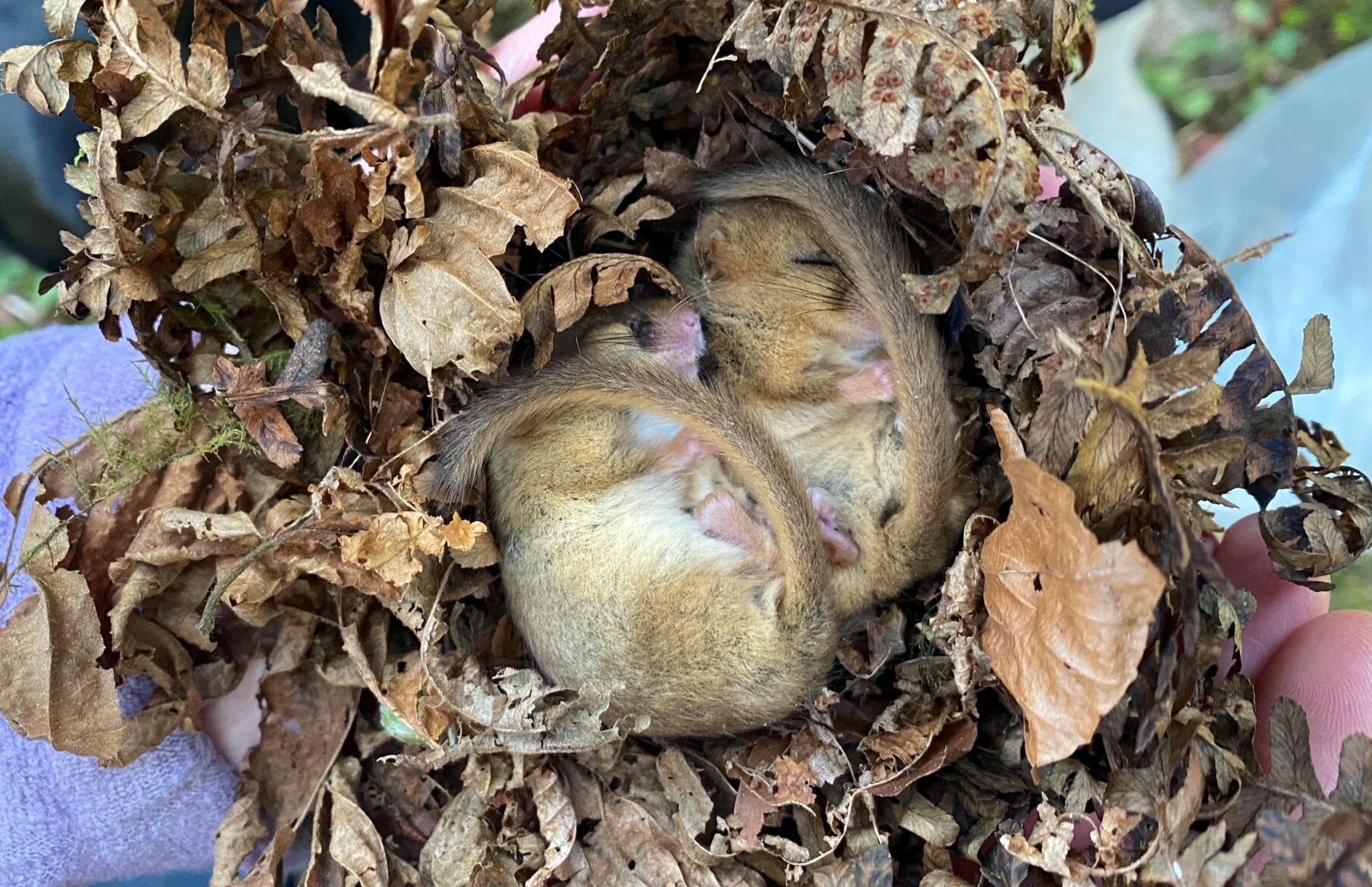To be added further to Consultation – agree what we want to say regs red squirrels, wild cats…..
Terrestrial mammals
Devon’s terrestrial mammals are some of our most iconic speciesA group of similar organisms that can breed and exchange gen... More.
However, they’re under pressure from things like loss of habitatThe natural environment in which an animal, plant or other o... More, litter, pesticides, lighting and climate change.
Nationally, hedgehogs have declined by as much as 73% in some rural areas.
1. About
Key pressures and opportunities
To be written further to Consultation
A Keep Britain Tidy (KBT) study estimates that 3 million small animals are killed by roadside litter every year, against a backdrop of 2 million pieces of litter dropped every day in the UK. This represents an unnecessary, additional ongoing challenge for the health of our wildlife, habitatsThe natural environment in which an animal, plant or other o... More, and biodiversity.
This 2016-17 Norfolk-based study sampled 2,174 bottles and from predominantly roadside locations and identified that 8% of littered glass bottles, and 5% of cans contained the remains of small animals (including shrews, voles, mice (including harvest mice) and insects(including beetles, woodlice, millipedes, slugs and snails).
Despite the proposed introduction of a ‘Deposit Return Scheme’ for single use drinks containers in 2027, the English scheme will exclude glass bottles. Overall, the study identified that there may be local effects on small animal populations from litter related deaths, particularly in areas with low species populations.
Glass bottles in East Devon have been found to contain the remains of hazel dormice. Hedgehogs can get caught up in litter such as yoghurt pots, tins and other plastics.
Promoting litter picking to protect wildlife should be a relatively quick win and links directly to our wellbeing by enabling us to connect with nature and feel empowered by taking critical direct action. Over 80% of people say that seeing litter on the streets makes then angry. There are also opportunities to highlight sensitive, designated sites and irreplaceable habitats for targeted litter control measures as part of routine operations. Devon County Council’s recent ‘Litter kills wildlife’ campaign in support of the Great British Spring Clean proved very popular with the public.
American mink
Climate change affects mammals in many different ways. For example, extreme weather such as drought and heavy rain can reduce the amount of plants and invertebrates available as food. With less food, mammals may fail to breed and are less likely to survive in winter, particularly small mammals such as harvest mice. Wet weather and warmer springs and winters can also disrupt hibernation and breeding patterns and lead to higher mortality.
Hedgehogs: Little is known about hedgehogs’ distribution in rural areas as the majority of records come from gardens,
Dormice: The easiest way to identify dormice is from the distinctive way they nibble hazelnuts. However, it can be hard to confirm their presence in habitats outside of broadleaved woodland and hedgerows, especially where there is no hazel. Nest boxes and tubes can be used, but require a licence and not all dormice will use artificial nests. Footprint tunnels don’t require a licence and are starting to be used on some sites.
2. What we need to do and where
Priority
Increase the abundance and distribution of terrestrial mammals across Devon, particularly those identified as Focus Species.
See Find out more below for detailed guidance and sources of funding and advice.
Focus species
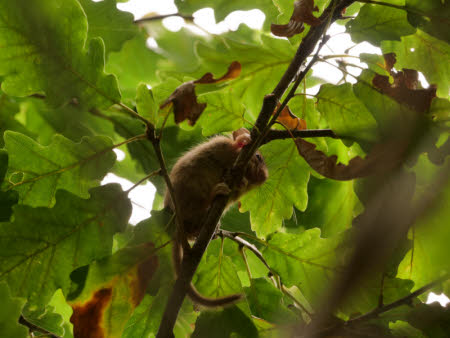
Hedgehogs and hazel dormice
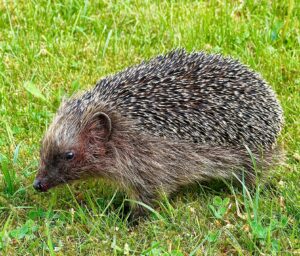
Hedgehog
Erinaceus europaeusHabitat
Hedgehogs are unmistakeable as they’re the UK’s only spiny mammal. They’re found in a wide range of densely-vegetated habitats such as the edges of broadleaved woodland, hedgerows, gardens and urban greenspaces.
Hedgehogs are generally solitary and are more active at night or in the early morning. They can travel 1-2 kms to feed on invertebrates such as beetles, worms, caterpillars, millipedes, leatherjackets and slugs. They also eat eggs and chicks, baby rodents, frogs, dead animals and fallen fruit.
Hedgehogs have one litter of hoglets a year, in June or July. They hibernate from November to March or April (depending on the weather) in a nest made of leaves that’s hidden away under a bush, pile of dead wood (including bonfire sites) or in an abandoned burrow. Their main predators are badgers, and sometimes foxes.
Population
Since 1995, the population of hedgehogs in rural areas is thought to have declined by 73%. Hedgehogs in gardens and greenspaces are thought to be doing better, although they’re still in decline. They are listed as threatened and are a UK priority species.
Hedgehogs are particularly affected by loss and fragmentation of habitat. Flailing causes hedges to develop gappy bases that provide less cover. Many hedgehogs are also killed crossing roads that separate their habitat. Fewer invertebrates also means they have less food.
Hedgehogs are found across Devon, other than the high ground of Dartmoor and Exmoor. They could be present in any suitable habitat.
As they’re largely active at night hedgehogs are not always seen. A good way to know if they’re present is to identify their tracks or droppings. Check the NBN atlas for records or contact DBRCDevon Biodiversity Records Centre More (see links in Find out more below).
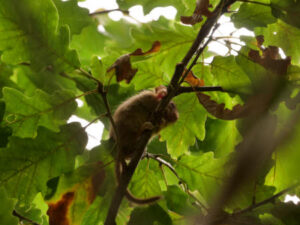
Hazel dormice
Muscardinus avellanariusHabitat
Hazel dormice live in the branches of trees and shrubs and, except for when they hibernate, rarely touch the ground. They can be found in a wide range of habitats that have good woody connectivity and lots of food. These include broadleaved woodland, hedges, heathland mosaics and scrubby grassland such as the culm, rhos pastures and coastal grasslands. They’ve also been seen in conifer woodlands, bramble patches and using bird feeders in gardens.
Hedges provide critical connectivity, allowing dormice to disperse into new habitats.
Hazel dormice are nocturnal. They feed on flowers, fruits, seeds, nuts (especially hazelnuts) and insects such as caterpillars and aphids. Important foodplants include hazel, oak, honeysuckle, bramble, willow, rowan and birch.
Dormice have one or two litters a year, usually between May and September. In summer they use plants such as honeysuckle and grasses to weave nests which they hide in holes in trees, old bird nests, dense scrubLand with thick vegetation that includes wildflowers, grasse... More and hedges. They generally don’t travel more than 70m from their nest.
Dormice build their hibernation nests at ground level, tucked among tree roots or under dead leaves, logs or moss.
Population
There has been a long-term decline in both the numbers and range of dormice. The main reason for this is thought to be habitat loss and deterioration. As a result, their UK conservation status assessment is unfavourable. Dormice are classed as nationally threatened, are a UK priority species and are legally protected.
Devon is a national stronghold for dormice and they can be found in suitable habitat throughout the county. There are few records in parts of rural north, west and south Devon but this may be due to lack of survey (as most records come from surveys for developments) rather than lack of dormice.
As dormice are nocturnal they’re not easy to spot. One way is to look for hazelnuts that have a neat, smooth hole, caused by the dormice’s precise nibbling. Check the NBN atlas for records or contact DBRC (see links in Find out more below).
Actions
Manage and create a network of connected woodlands, hedgerows and trees in rural and urban areas with dense shrubs and abundant flowers and invertebrates.
- Manage woodlands (through techniques such as selective felling, coppicingA traditional way to manage woodland where trees are felled ... More, ride management and deer control) to create a mosaic of woodland habitats with canopy trees, a dense understorey (including hazel) and open rides and glades. See Broadleaved woodlands and Conifer and mixed woodlands for more details and links.
- Maintain a network of dense, species-rich hedges and margins across Devon that include standard trees. See Hedges for details.
- Protect and manage mosaics of flower-rich grasslands with networks of dense scrub (shrubs and brambles). See Wetland mosaics and Coastal wildbelt for details.
- Create a network of wildlife-rich gardens and greenspaces. See Gardens and Greenspaces for details.
- Make sure all fences have a gap big enough for hedgehogs and other small mammals to pass through.
- Check for nests before carrying out work such as strimming and tree works (note it is a criminal offence to kill or disturb nesting dormice). Ideally carry out work in and around October, after the dormice breed and before they hibernate.
Provide safe road crossings for wildlife
Include wildlife underpasses under new roads, following the latest guidance. Retrofit where possible.
Reduce the use of pesticides
Add any detailed wording for actions following further discussion with farming group
Reduce litter agree wording with DCC waste team
- Everyone to reduce littering and to litter pick as a normal part of day to day life.
- Local Authorities to target routine litter operations to wildlife-rich sites, guided by the LNRS mapping.
- Further develop and promote Devon County Council’s ‘Litter kills wildlife’ campaign in support of the Great British Spring Clean.
Raise awareness
- Raise awareness of dormice and hedgehogs among all landmanagers, such as farmers, foresters, gardeners and landscape contractors.
- Use dormice and hedgehogs as flagship species to encourage the management and creation of woody habitats.
Research, survey and monitoring
- Develop a more strategic approach to monitoring dormice populations. Use new survey methods such as e-DNA, radio tracking, thermal cameras and footprint tunnels. Extend the National Dormouse Monitoring Programme and share records with DBRC and PTESPeople's Trust for Endangered Species More.
- Share monitoring of habitat created as mitigation for new development with Natural England and PTES to better understand how to compensate for loss of dormouse habitat. ???
- Carry out further research into effective road crossings for hedgehogs and dormice.
Legislation and policy
- Pilot a more effective system for licencing and planning through the Devon and Dorset Dormouse Species Conservation Strategy, led by Natural England. This should provide greater benefits for dormice, reduce bureaucracy and allow a more strategic approach to monitoring (see above).
- Consider hedgehogs in impact assessments for infrastructure projects and planning applications.
Where to focus action
Actions are needed across Devon as dormice and hedgehogs are found in low numbers across the county.
Pine marten
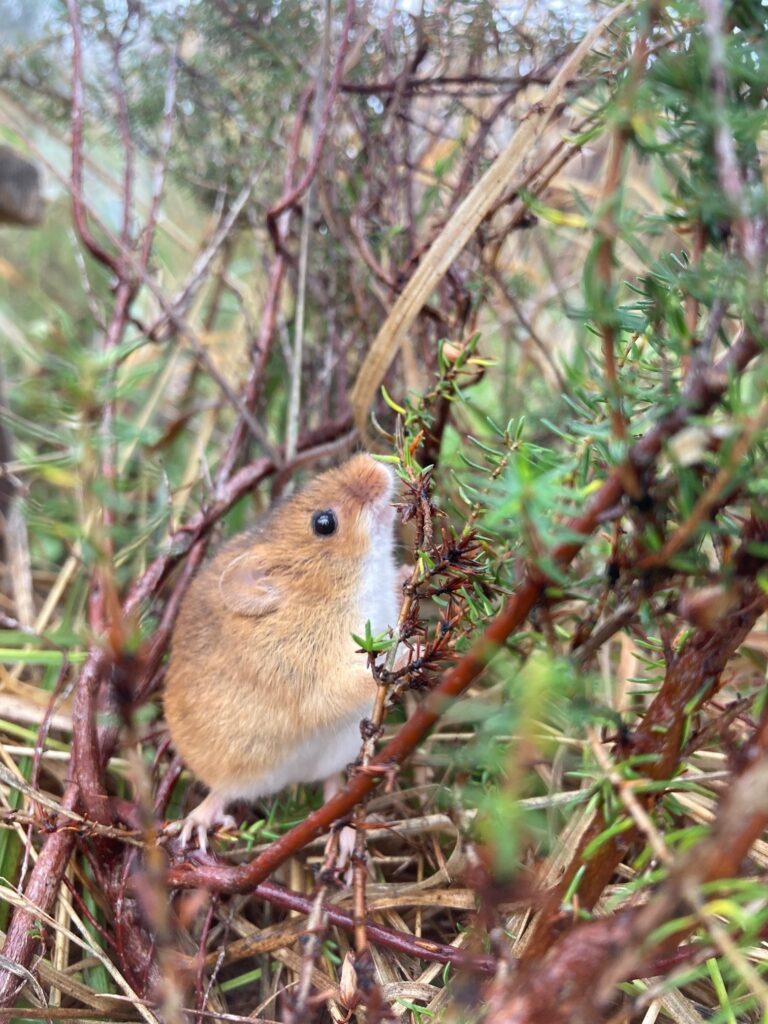
Harvest mice
Micromys minutusHabitat
Harvest mice are Europe’s smallest rodent, weighing only 6-9g. They’re found anywhere that has abundant food and tall, tussocky grasses or reeds such as hedgerow corridors, tussocky grasslands, road verges, reedbeds, ditches and saltmarshes. They’re good climbers and live mostly in the stalk zone where they feed on seeds, berries and insects. They are now rarely found in cereal crops as the gaps between stems are usually too wide for the mice to build their nests.
Grass tussocks need to be at least a year old before they’re strong enough to support nests. Species which form tussocks include cock’s foot, tufted hair-grass, reed canary-grass, reed sweet-grass and purple moor-grass. Harvest mice build their nests by splitting and weaving the leaves of grasses or reeds. The nests stay attached to the stem, generally over half way up.
Harvest mice usually have two to three litters a year, between May and October although they can breed into December. They don’t hibernate.
Population
Due to a lack of national survey, little is known about the national population. The Mammal Society believes that numbers have declined nationally due to loss of habitat and they are a UK priority species.
The Devon Harvest Mouse Project is working with volunteers to find out more about the county’s population. Results to date show that they seem to be widespread across Devon but in low numbers and potentially declining.
Actions
Manage and create a network of connected habitats with tussocky grasses or reeds for harvest mice nests and with abundant insects, berries and seeds for food.
- Lightly graze grassland to maintain or create mature tussocks.
- Implement cutting regimes to maintain or create mature grassy tussocks along road verges, railway corridors and other greenspaces. Where possible, cut on a two to three-year cycle, with only part of the site being cut at any one time.
- Manage hedgerow margins to maintain or create mature grassy tussocks.
Awareness
Raise awareness of harvest mice among landowners, land managers, landscape contractors and highways authorities.
Research, survey and monitoring
Support the Devon Harvest Mouse Project to continue their work with land managers and volunteers.
Legislation and policy
Consider harvest mice in impact assessments for infrastructure projects and planning applications.
Where to focus action
Actions are needed across Devon.
Actions for all terrestrial mammals
Habitat management and creation
All terrestrial mammals will benefit from the actions listed above and actions set out in the Habitat pages.
Relevant habitat page links to be added during consultation
3. Inspiration
Case studies
Case studies and Where to visit will be agreed following discussion through public consultation period and then finalised.
There’s lots of great work going on across Devon for terrestrial mammals. For example:
Project started in 2024 in South Devon with a focus on dormice, hedgehogs and bats.
Devon Harvest Mouse Project
Devon Harvest Mouse Project was set up in 2016 by the Devon Mammals Group to research harvest mice in Devon. The project works with land management-based conservation projects such as Moor Meadows and the Avon Valley Project to raise awareness of harvest mice and run survey training.
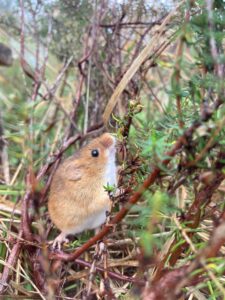
Could include pine marten reintroduction / Connecting People and Landscapes / Litter campaign
Where to visit
Always follow the Countryside Code and keep to footpaths and sites that are managed for public access.
Good places to see terrestrial mammals are:
For information on visiting these and other sites that are open to the public please see the Explore Devon website.
4. Find out more
Add more links and tidy up, and finalise following discussion through public consultation.
Devon Mammal Group is open to anyone with an interest in mammals. They organise talks and events and lead the Devon Harvest Mouse Project.
The Mammal Society website has information on all species, including how to identify them or their signs (such as tracks and droppings).
IUCN approved Red List for Britain’s Mammals.
The JNCC Conservation Designations for UK Taxa 2023 contains data from the
JNCCJoint Nature Conservation Committee More, NE, NR, NatureScot and NIEA © Copyright and database right 2023.
JNCC UK BAP List of UK Priority Species 2007
The NBN Atlas has species records and a search function that pulls up records for a specific area. Health warning: The Atlas shows records submitted and not the actual distribution of species. Therefore absence on the map does not mean absence. Some of the records are also quite old and the species may no longer be present.
Devon Biodiversity Records Centre (DBRC) collects, manages and makes available records of wildlife. Note: they may charge depending on the reason for the request.
iNaturalistUK helps you identify wildlife and share records.
The Wildlife Trusts have worked with National Highways to improve connectivity for wildlife – see Network for Nature | The Wildlife Trusts
The British Hedgehog Preservation Society (BHPS) funds research and raises awareness of hedgehogs and their needs.
The People’s Trust for Endangered Species (PTES) works with the BHPS to coordinate hedgehog conservation work across the UK, including national surveys. There’s lots of useful information on their website.
Hedgehog Street, run by PTES and BHPS, encourages people to make gardens more hedgehog-friendly.
Devon Wildlife Trust led a hedgehog survey in 2011. The details are available from DBRC.
The People’s Trust for Endangered Species (PTES) coordinates dormouse conservation work across the UK, including national surveys. There’s lots of useful information on their website.
The Devon Mammal Group funded a 2013 report on dormice in gardens.
Managing woodlands and hedges for dormice
PTES guidance on managing woodlands for dormice (includes links to the Dormouse Conservation Handbook and PTES leaflet).
Devon Hedge Group has a leaflet on the importance of hedges as habitat for dormice.
PTES runs the National Dormouse Monitoring Programme (NDMP), which monitors the long-term dormouse population trend. Volunteers set up and monitor sites that have a minimum of 50 nest boxes. There are 103 NDMP sites in Devon. 82 have been monitored at some point between 2012 and 2022 and 53 of these were still active in 2022.
PTES also report on The State of Britain’s Dormice.
The National Dormouse Footprint Tunnel Survey is a pilot project run by PTES and Natural England to detect the presence of dormice in hedgerows. The project also assesses the condition of the hedgerow using the Great British Hedgerow Survey.
Devon-based K9 commando is piloting the use of sniffer dogs to survey for dormice.
PTES ran The Great Nut Hunt in 1993 and 2001. The first survey identified 81 sites in Devon with dormice. It’s a good way for members of the public to survey for dormice, as it does not require a licence. DBRC has the records from these surveys
Nest tube surveys can be used in areas where nut hunts are unlikely to be effective. A licence is required to check nest tubes if dormice are likely to be present.
The Woodland Trust and National Trust are carrying out conservation for dormice in Fingle Woods.
Devon Wildlife Trust’s Avon Valley Project is helping increase the population of dormice in the area.
The Blackdown Hills Natural Futures Project (2015-2017) led to 30+ new volunteers surveying 300 new dormice nest boxes in five new monitoring sites
Ellie Scopes: Are hazel dormice Muscardinus avellanarius Endangered?
Charlotte Armitage: Conservation of the hazel dormouse on the edge of the species’ range.
Cecily Goodwin: How woodland management can help save dormice.
Leo Gubert: Hibernation ecology and population biology of the hazel dormouse.
Cheryl Mills: Non-invasive methods for surveying dormice.
All these projects were short-term, generally lasting two or three years. The National Dormouse Monitoring Programme is the only long-term project, running since the 1990s.
The Devon Mammal Group runs a harvest mouse project that aims to find out how the species is doing in Devon and where they can be found.
The Mammal Society runs the National Harvest Mouse Survey. They’re looking for volunteers who can get outside and look for harvest mouse nests.

